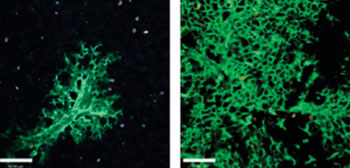Bone Marrow Transplantation Techniques Are Successfully Adapted for Lung Repair
By LabMedica International staff writers
Posted on 30 Jul 2015
A new approach for repairing the damage caused to lung tissue by diseases such as emphysema, bronchitis, asthma, and cystic fibrosis is based on transplanting embryonic stem cells into damaged lungs that have been conditioned by radiation treatment.Posted on 30 Jul 2015
Investigators at the Weizmann Institute of Science (Rehovot, Israel) recognized the similarity between the arrangement of cellular compartments within the lung and the arrangement of similar compartments in the bone marrow. They reasoned that methods used for bone marrow transplantation might prove useful for inducing stem cells to mature into functional lung tissue.

Image: New lung cells are continuously created to replace the damaged ones: Lung tissue six weeks after stem cell transplantation (left) and 16 weeks after transplantation (right). Cells that originated in the transplanted stem cells are green, as opposed to the uncolored host lung cells (Photo courtesy of the Weizmann Institute of Science).
Initial experiments indicated that human and mouse embryonic lung tissue from the canalicular stage of development (20–22 weeks of gestation for humans, and embryonic day 15–16 for the mouse) were enriched with stem cell progenitors residing in distinct niches. Younger cells had not yet completed the process of differentiation, while older cells were less capable of lung regeneration.
The investigators exposed naphthalene-injured, lung damaged mice to doses of sublethal radiation to empty out lung progenitor niches and to reduce stem cell competition. A single cell suspension of canalicular lung tissue of either mouse or human fetal origin was then administered intravenously.
Results published in the July 13, 2015, online edition of the journal Nature Medicine revealed that recipients of the single cell suspension transplant exhibited marked improvement in lung compliance. The treatment induced marked long-term lung chimerism with donor type structures or "patches" that contained epithelial, mesenchymal, and endothelial cells.
"Certain stem cells that normally reside in the lungs are highly similar to those in the bone marrow," said senior author Dr. Yair Reisner, professor of immunology at the Weizmann Institute of Science. "In each organ, the stem cells, rather than being distributed throughout the tissue, are concentrated in special compartments that contain all the provisions that stem cells need. That understanding suggested to us that we might be able to apply our knowledge of techniques for transplanting bone marrow stem cells to repairing lung tissue, but our real vision, bolstered by this success, is to create a bank of lung tissue that will be a resource for embryonic lung stem cells."
Related Links:
Weizmann Institute of Science













